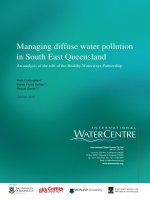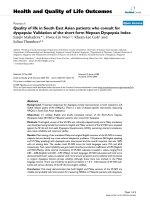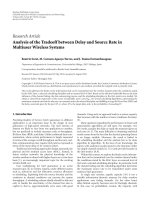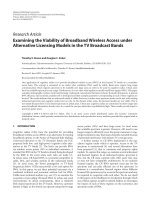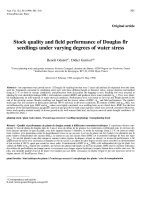Performance of Makhangrass (Lolium multiflorum) under various seed rate in south East Rajasthan, India
Bạn đang xem bản rút gọn của tài liệu. Xem và tải ngay bản đầy đủ của tài liệu tại đây (269.83 KB, 6 trang )
Int.J.Curr.Microbiol.App.Sci (2017) 6(5): 1945-1950
International Journal of Current Microbiology and Applied Sciences
ISSN: 2319-7706 Volume 6 Number 5 (2017) pp. 1945-1950
Journal homepage:
Original Research Article
/>
Performance of Makhangrass (Lolium multiflorum) under
Various Seed Rate in South East Rajasthan, India
Harphool Meena*, R.S. Narolia, Pratap Singh, P.K.P. Meena and B.L. Kumhar
AICRP on Irrigation Water Management, Agricultural Research Station, Ummedganj Farm
Agriculture University, Kota-324001, Rajasthan, India
*Corresponding author
ABSTRACT
Keywords
Makhangrass,
Seed rate
and
Berseem
Article Info
Accepted:
19 April 2017
Available Online:
10 May 2017
A field experiment was conducted during two consecutive years from 201415 and 2015-16 at Agricultural Research Station, Kota, entitled
“Performance of Makhangrass (Loliu multiflorum) under various seed rate
in South East Rajasthan. Sowing of makhangrass with 14 kg seed/ha gave
significantly higher green fodder yield (879 q/ha) and dry fodder yield (178
q/ha) over berseem sowing (25.0 kg seed/ha) by giving green fodder yield
(690 q/ha) and dry fodder yield (142 q/ha). However, sowing of
makhangrass with 13.0 and 15.0 kg seed/ha were at par with each other but
it was found significantly superior over 12.0 and 16.0 kg seed/ha.
Introduction
Makhangrass (Loliummultiflorum Lam.), also
called Italian ryegrass) is a cool season
annual bunchgrass native to southern Europe.
It is closely related to perennial ryegrass
(Lolium perenne L.). Both are widely
distributed throughout the world, including
North and South America, Europe, New
Zealand, and Australia. Makhangrass is an
important short duration grass. High
palatability and digestibility make this species
highly valued for forage. It is used in many
environments when fast cover or quick feed is
required. Characteristics include: High yield
potential, fast establishment, suitability for
reduced-tillage renovation and use on heavy
and waterlogged soils (Rana et al., 2013).
The agriculture and livestock sector provides
employment to 52 per cent of the work force.
Even being highest livestock population
(529.7 million) in India (Anonymous, 201112), supporting nearly 20 per cent of the
world livestock and 16.8 per cent human
population on a land area of only 2.3 per cent,
India faces a net deficit of 62.7 per cent green
fodder, 21.9 per cent dry crop residues and 64
per cent feeds. During 2010, supply of green
forages and roughages was 395.2 and 451
million tonnes against the demand of 1061
and 589 million tonnes, respectively (ICAR,
2012). Makhangrass is highly nutritional
multicut, highly succulent and the most
palatable grass in the World. Makhangrass
feeding will greatly improve milk production
1945
Int.J.Curr.Microbiol.App.Sci (2017) 6(5): 1945-1950
and quality (especially milk solids), it is
considered to be one of the highest quality
winter forages utilized in the World. Dry
matter digestibility is generally greater than
65 per cent, and crude protein content exceeds
the requirements for most classes of livestock
animal gains.
Among crop management practices seeding
densities or plant population greatly affect
crop growth and then finally yield. Therefore
seeding density is a key factor in assessing the
flexibility and yielding ability of cultivars.
Both over and substandard plant population is
the major cause of low yield (Jan et al.,
2000). Optimum seed rate plays an important
role in contributing to the high yield because
in case of thick plant population, most plants
remain sterile, easily attacked by diseases as
compared to normal population Robert and
Singh (1981).
Whether by mechanical clipping or grazing,
defoliation management greatly influences
forage quality, productivity, and persistence.
Quality is most affected by maturity stage at
harvest. To obtain high quality preserved
forage (silage or hay), harvest annual
makhangrass at the boot stage. For silage, let
plants wilt prior to ensiling and lower
moisture content will reduce effluent losses
from silage. In the India, three to four cutting
are possible, typical yield distribution is 30-35
percent in the first cutting, 35-40 percent in
the second cutting and 20-25 percent in
subsequent cutting. More consistently high
quality forage is obtained by grazing, green
chopping and ensiling early spring growth to
stimulate recovery growth, fertilize with
nitrogen immediately following the initial
cutting (Smith et al., 2005).
Materials and Methods
Experiment was conducted during two
consecutive years from 2014-15 and 2015-16
at Agricultural Research Station, Kota. The
experimental field was well prepared by two
ploughing followed by harrowing and
cultivator and one planking for uniform
leveling were performed for sowing of
makhangrass. The experiment was laid-out in
Randomized Block Design with four
replications having six treatments i.e. T1:
Makhangrass (seed rate 12 kg/ha), T2:
Makhangrass (seed rate 13 kg/ha), T3:
Makhangrass (seed rate 14 kg/ha), T4:
Makhangrass (seed rate 15 kg/ha), T5:
Makhangrass (seed rate 16 kg/ha) and T6:
Berseem (seed rate 25 kg/ha) control.
The bulk density, pH and cation exchange
capacity of these soils varies between 1.301.60 Mg/m3, 7.75-8.50 and 30-40 Cmol/kg,
respectively. The soils of the region are poor
in organic carbon (0.50±0.08) and available
nitrogen (275±5 kg/ha) but are low to medium
in available P2O5 (24.2± 1.0 kg/ha) and
medium to high in available K2O (290 ± 8
kg/ha). The recommended dose of nitrogen,
phosphorus and potash i.e.150 kg N/ha, 60 kg
P2O5 / ha and 60 kg K2O /ha was applied
through urea, di-ammonium phosphate (DAP)
and muriate of potash (MOP), respectively.
Full dose of DAP and MOP and 50 kg N were
drilled just before sowing and remaining
nitrogen were applied in three split doses at
30,50 and 80 DAS.
Results and Discussion
Plant population
Pooled data shows that, the plant population
of makhangrass significantly influenced by
sowing of different seed rate (Table 1).
Significantly higher plant population (6,72,
625/ha) of makhangrass was recorded with
the sowing of 16 kg seed/ha which was
significantly superior over sowing of
makhangrass with different seed rate and
berseem sowing with 25 kg seed/ha.
1946
Int.J.Curr.Microbiol.App.Sci (2017) 6(5): 1945-1950
Ist cutting
Pooled data shows that the growth parameters
of makhangrass significantly influenced by
sowing of different seed rate (Table 1).
Significantly higher plant height (40.62 cm)
and leaf weight/10 plants (29.07g) of
makhangrass were recorded with the sowing
of 12 kg seed/ha over sowing of makhangrass
with 13, 14, 15 and 16 kg/ha seed rate and
berseem sowing with 25 kg seed/ha,
respectively. The maximum stem weight/10
plants (17.30 g) was recorded with the sowing
of makhangrass by 12 kg seed/ha but it was
found at par with sowing of makhangrass 13
kg seed/ha over sowing of makhangrass with
different seed rate and berseem sowing with
25 kg seed/ha. Fodder yield was significantly
influenced by sowing of different seed rate of
makhangrass (Table 1). Pooled data of two
years shows that the sowing of makhangrass
with 14.0 kg seed/ha was observed to provide
maximum green fodder yield (305 q/ha) and
dry fodder yield (62 q/ha) which was
significantly superior to berseem sowing (25
kg seed/ha) having green fodder yield (210
q/ha) and dry fodder yield (43q/ha). However,
sowing of makhangrass with 15.0 and 16.0 kg
seed/ha were statistically non significant.
These results are in close proximity with
those of Smith et al., (2005) and Rana et al.,
(2013).
IInd cutting
During IInd cutting growth parameters were
significantly influenced (Table 2) by sowing
of different seed rate of makhangrass. Pooled
data of two years show that the maximum
plant height (44.88 cm) was recorded with the
sowing of berseem (25.0 kg seed/ha) over
sowing of makhangrass with different seed
rate. Significantly higher leaf weight/10
plants (30.6 g) with the sowing of
makhangrass 12.0 kg seed/ha over sowing of
makhangrass with different seed rate and
berseem 25 kg seed/ha, respectively. The
maximum stem weight/10 plants (23.80 g)
was recorded with the sowing of berseem
(25.0 kg seed/ha) over sowing of
makhangrass with different seed rate. Fodder
yield was significantly influenced by sowing
of different seed rate of makhangrass (Table
2). Pooled data of over two years shows that
the maximum green fodder yield (363 q/ha)
and dry fodder yield (73 q/ha) were recorded
under sowing of makhangrass 14.0 kg seed/ha
but it was found at par with the sowing of
makhangrass 15.0 kg seed/ha over different
seed rate of makhangrass and berseem sowing
with 25.0 kg seed/ha. Similar results indicated
by Smith et al., (2005), Rana et al., (2013)
and Prajapati et al., (2017).
IIIrd cutting
Plant growth was significantly influenced
(Table 3) by sowing of different seed rate of
makhangrass. The maximum plant height
(35.1cm) and leaf weight/10 plants (25.5 g) of
makhangrass were recorded with the sowing
of 12.0 kg seed/ha over sowing of
makhangrass with different seed rate and
berseem sowing with 25 kg seed/ha,
respectively. Significantly higher stem weight
(14.56 g) was observed with the sowing of
makhangrass 12.0 kg seed/ha over different
seed rate of makhangrass and sowing of
berseem with 25.0 kg seed/ha. However, it
was found at par with sowing of makhangrass
13.0 kg seed/ha. Makhangrass fodder yield
was significantly influenced by sowing of
different seed rate (Table 9). The pooled data
shows that the significantly higher green
fodder yield (211 q/ha) and dry fodder yield
(42 q/ha) were recorded sowing of
makhangrass by 14.0 kg seed/ha over sowing
of makhangrass by 12.0 and 16.0 kg seed/ha
and berseem sowing with 25.0 kg seed/ha.
However, it was found at par with sowing of
makhangrass by 13.0 and 15.0 kg seed/ha,
respectively.
1947
Int.J.Curr.Microbiol.App.Sci (2017) 6(5): 1945-1950
Table.1 Effect of different seed rate on plant population, growth and fodder yield of makhangrass (Ist cutting)
Treatments
Seed rate 12 kg/ha
Seed rate 13 kg/ha
Seed rate 14 kg/ha
Seed rate 15 kg/ha
Seed rate 16 kg/ha
Berseem 25 kg/ha
SEm ±
CD at 5 %
Plant population
(thousand/ha)
2015
2016
Pooled
522500
565000
610000
630000
672500
595000
4916
14806
522520
565233
610278
630250
672750
596500
5019
15118
522510
565117
610139
630125
672625
595750
4570
13773
Plant height (cm)
2015
2016
Poole
d
Weight of leaves/10
plants (g)
2015
2016 Poole
d
40.50
37.75
36.50
35.75
29.25
38.00
0.55
1.65
40.75
37.93
36.65
35.95
29.41
38.19
0.53
1.61
40.62
37.84
36.57
35.85
29.33
38.09
0.49
1.52
29.00
27.50
26.75
26.00
22.25
7.63
0.56
1.70
29.15
27.36
26.91
26.15
22.40
7.88
0.51
1.55
29.07
27.43
26.83
26.07
22.32
7.75
0.48
1.50
Weight of stem/10
plants (g)
2015
2016
Poole
d
Green fodder yield
(q/ha)
2015
2016 Pooled
17.25
16.25
14.75
14.00
13.00
9.50
0.58
1.76
259
289
304
294
290
209
5.08
15.30
17.35
16.38
14.86
14.13
13.14
9.64
0.55
1.67
17.30
16.31
14.80
14.06
13.07
9.57
0.51
1.56
261
295
306
297
292
212
4.51
13.59
260
292
305
295
291
210
4.41
13.29
Dry fodder yield (q/ha)
2015
201
6
Poole
d
52
60
62
61
57
42
0.91
2.73
53
61
64
63
60
43
0.87
2.63
53
61
63
62
59
43
0.81
2.46
Dry
matter
(%)
20.38
20.89
20.65
21.01
20.27
20.47
-
Table.2 Effect of different seed rate on growth and fodder yield of makhangrass (IInd cutting)
Treatments
Plant height (cm)
Weight of leaves/10 plants
(g)
2015
2016
Pooled
Weight of stem/10 plants
(g)
2015
2016
Pooled
2015
2016
Pooled
2015
2016
Pooled
Green fodder yield (q/ha)
Dry fodder yield (q/ha)
2015
2016
Pooled
Seed rate 12 kg/ha
Seed rate 13 kg/ha
43.75
41.25
44.00
41.55
43.88
41.40
30.75
28.50
30.49
28.75
30.6
28.6
20.25
18.55
20.35
18.81
20.3
18.7
319
346
321
350
320
348
64
69
65
72
65
71
Dry matter
(%)
20.31
20.40
Seed rate 14 kg/ha
Seed rate 15 kg/ha
Seed rate 16 kg/ha
40.25
39.25
31.75
40.33
39.28
31.80
40.29
39.27
31.78
27.75
27.25
23.25
27.99
27.50
23.50
27.9
27.4
23.4
17.50
17.00
15.00
17.62
17.10
15.13
17.6
17.1
15.1
361
349
337
364
351
339
363
350
338
72
70
67
73
72
67
73
71
67
20.11
20.28
19.82
Berseem 25 kg/ha
SEm ±
CD at 5 %
46.00
0.52
1.57
43.75
0.48
1.45
44.88
0.46
1.38
10.63
0.48
1.46
10.86
0.48
1.44
10.7
0.44
1.33
23.75
0.56
1.68
23.87
0.49
1.48
23.8
0.48
1.45
318
5.72
17.23
320
5.16
15.54
319
5.00
15.08
65
1.09
3.30
66
1.03
3.10
66
0.97
2.93
20.68
-
1948
Int.J.Curr.Microbiol.App.Sci (2017) 6(5): 1945-1950
Table.3 Effect of different seed rate on growth and fodder yield of makhangrass (IIIrd cutting)
Treatments
Plant height (cm)
Weight of leaves/10 plants
(g)
2015
2016
Pooled
Weight of stem/10 plants
(g)
2015
2016
Pooled
2015
2016
Pooled
2015
2016
Pooled
Green fodder yield (q/ha)
Dry fodder yield (q/ha)
2015
2016
Pooled
Seed rate 12 kg/ha
Seed rate 13 kg/ha
35.00
32.75
35.20
32.98
35.1
32.9
25.00
21.75
26.00
21.96
25.5
21.9
14.50
14.25
14.61
14.35
14.56
14.30
157
200
158
201
158
201
31
39
32
40
32
40
Dry matter
(%)
20.25
19.90
Seed rate 14 kg/ha
Seed rate 15 kg/ha
Seed rate 16 kg/ha
31.50
30.75
26.00
31.71
30.96
26.20
31.6
30.9
26.1
21.00
19.50
18.50
21.22
19.73
18.74
21.1
19.6
18.6
13.00
12.25
10.75
13.13
12.38
10.86
13.07
12.32
10.81
210
202
190
212
204
189
211
203
190
41
40
38
42
41
39
42
41
39
19.90
20.19
20.52
Berseem 25 kg/ha
SEm ±
CD at 5 %
30.00
0.57
1.73
33.05
0.53
1.60
31.5
0.50
1.52
6.50
0.34
1.01
6.75
0.28
0.83
6.6
0.28
0.85
7.50
0.41
1.24
7.63
0.38
1.15
7.57
0.39
1.19
161
4.66
14.05
161
4.44
13.39
161
4.18
12.61
32
0.77
2.32
33
0.83
2.51
33
0.73
2.21
20.49
-
Table.4 Mean green and dry fodder yield of Makhangrass during Ist, IInd andIIIrdcutting
Treatments
Green fodder yield (q/ha)
Istcutting
Seed rate 12 kg/ha
Seed rate 13 kg/ha
Seed rate 14 kg/ha
Seed rate 15 kg/ha
Seed rate 16 kg/ha
Berseem 25 kg/ha
SEm ±
CD at 5 %
260
IInd
cutting
320
IIIrd
cutting
158
292
305
295
291
210
4.41
348
363
350
338
319
5.00
201
211
203
190
161
4.18
13.29
15.08
12.61
Dry fodder yield (q/ha)
Total
Istcutti
ng
IInd
cutting
IIIrd
cutting
Total
738
841
879
848
819
690
-
53
61
63
62
59
43
0.81
2.46
65
71
73
71
67
66
0.97
2.93
32
40
42
41
39
33
0.73
2.21
150
172
178
174
165
142
General View of Experimental plot
1949
Int.J.Curr.Microbiol.App.Sci (2017) 6(5): 1945-1950
These results are in close proximity with
those of Joshi et al., 2005 and Prajapati et al.,
2017.
In conclusion, the results of the field
experiment
entitled
“Performance
of
makhangrass (Lolium multiflorum)” indicated
that sowing of makhangrass using 14.0 kg
seed/ha appear to be beneficial for obtaining
higher green and dry fodder yield. Sowing of
makhangrass with 14 kg seed/ha gave
significantly higher green fodder yield (879
q/ha) and dry fodder yield (178 q/ha) over
berseem sowing (25.0 kg seed/ha) by giving
green fodder yield (690 q/ha) and dry fodder
yield (142 q/ha).However, sowing of
makhangrass with 13.0 and 15.0 kg seed/ha
were at par with each other but was found
significant over 12.0 and 16.0 kg seed/ha.
Makhangrass may be suitable for green
fodder purpose in winter season.
References
Anonymous.
2011-2012.
Ministry
of
Agriculture Government of India, 150
p.
ICAR (Indian Council of Agricultural
Research, New Delhi). 2012. Handbook
of Agri., pp. 1353-1417.
Jan, A., Kaleem, S.A., Taj, F.H. and Khan, H.
2000. Response of mungbean cultivars
to different seeding densities at dry land
conditions, Pak. J. Biol. Sci., 3: 2030–
32.
Joshi, Y.P., H. Singh and R.L. Bhilare. 2005.
Response of cutting management effects
on growth, forage yield and quality of
oat varieties. Pantnagar J. Res., 3: 1718.
Prajapati, B., Bhatnagar, A. and Kewalanand.
2017. Quality analysis of winter season
forage crops. Forage Res., 42: pp. 252257.
Rana, D.S., Singh, B., Gupta, K., Dhaka, A.K.
and Pahuja, S.K. 2013. Effect of fertility
levels on growth, yield and quality of
multi-cut forage sorghum [Sorghum
bicolor (L.)Moench] genotypes. Forage
Res., 39: 36-38.
Robert, W. and Singh, K. 1981. Food Grain,
A Text Book of Punjab Agriculture,.
Civil and Ministry Gazette, Lahore,
287.
Smith, H.J., B.M. Tast, H.Z. Taweet, S.
Tammingat and A. Elgersma. 2005.
Effect of perennial ryegrass (Lolium
perenne L.) cultivars on herbage
production, nutritional quality and
herbage intake of grazing dairy cows.
Grass and Forage Sci., 60: 297-309.
How to cite this article:
Harphool Meena, R.S. Narolia, Pratap Singh, P.K.P. Meena and Kumhar, B.L. 2017.
Performance of Makhangrass (Lolium multiflorum) under Various Seed Rate in South East
Rajasthan. Int.J.Curr.Microbiol.App.Sci. 6(5): 1945-1950.
doi: />
1950
